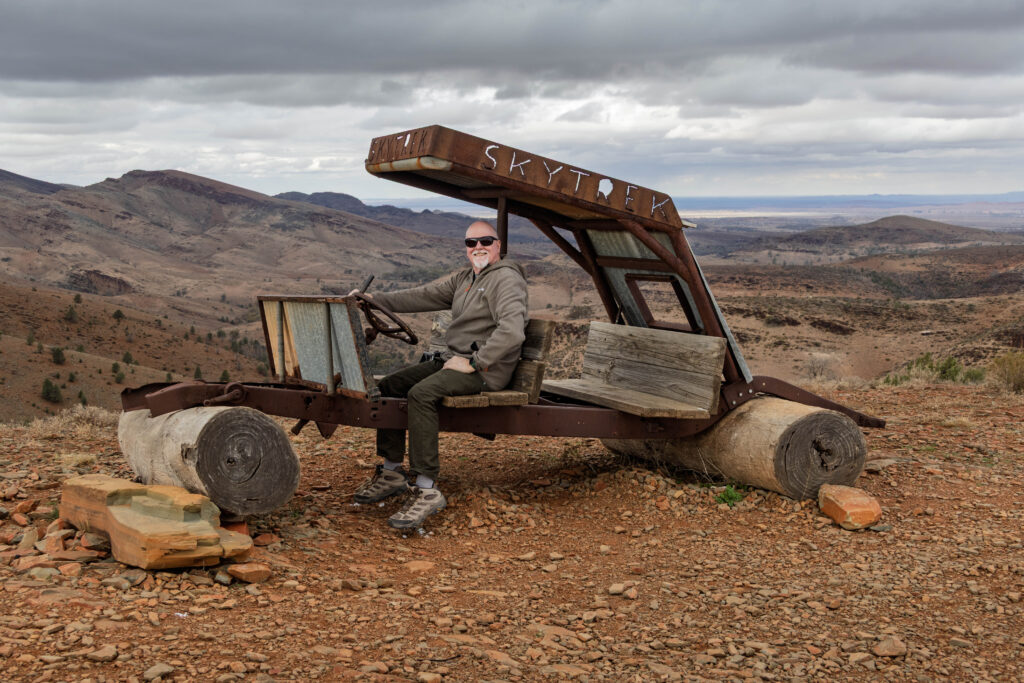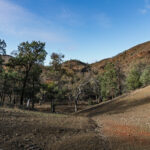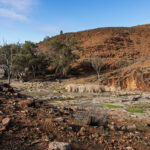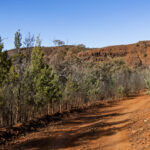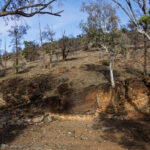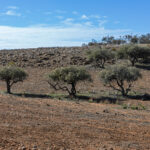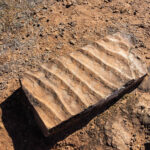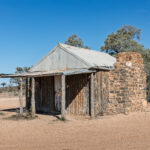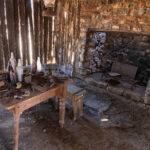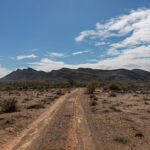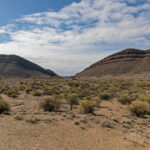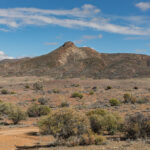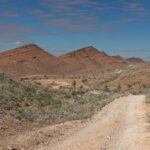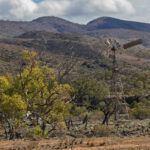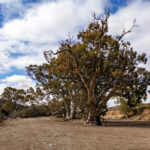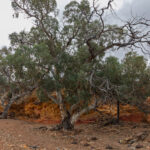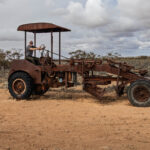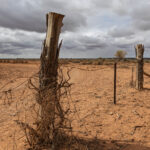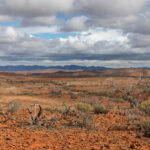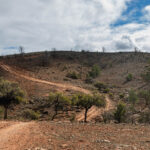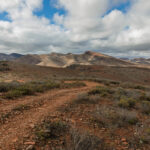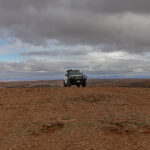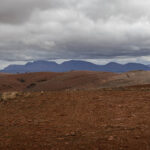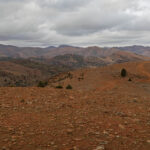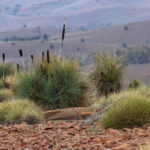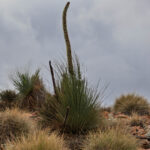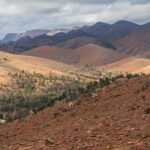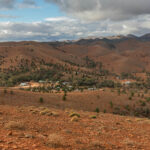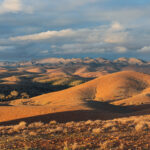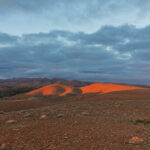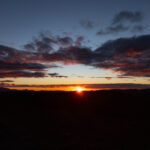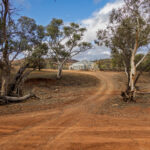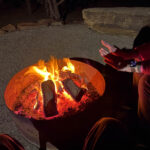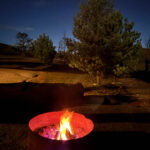Sunday, 10 August 2025
Today was a day of two halves. This morning the weather was magnificent, this afternoon not so much. Our four wheel driving started out an easy enough drive along the Willow Spring Station’s ‘Skytrek’ but, after our lunch stop, it was much more challenging.
But, before I go into today’s 4WD adventure in detail I must mention that when it was half time last night in the Port Adelaide vs Fremantle football match, Bernie went out in the freezing cold (well, not quite freezing, but very cold) to load the blog at the camp kitchen where wi-fi is available. Such dedication to the travelblog!
This morning we made our breakfast in the Overseer’s Cottage that used to house a family of five. That must have been very cozy with only two rooms, a kitchenette and a bathroom. It’s quite cozy for two, let alone five! Later, between 1960 and 1975, the building was used as the school of the air schoolroom by the Reynolds children.
Skytrek takes around seven hours to complete so we headed off just before 9.00am so that we would make it back before dark. The owners don’t let anyone depart after 10.30am so we felt a 9.00am departure would provide us with a decent buffer to ensure we could take it easily and not feel under any pressure at the end to get back by 5.00pm.
We left our cottage and made our way down to the start of the Skytrek route and then through the first gate. Within a kilometre we were making our way through young native pine trees and our guide informed us that they often look like they have been planted because of their uniform height and distribution, but this is, in fact, due to floods causing germination ‘events’ that result in thousands of seedlings in localized areas.
We passed our first natural spring on this property that is well served by spring water and bore water, before entering the first of many stands of river red gums that stand along the line of the rivers and creeks that flow during the rainy periods. These are such magnificent trees providing habitat for birds, bats, possums, reptiles and many insects.
Next our attention was drawn to the Large Boulder on the left hand side of the track. This boulder fell from the face of the gorge in June 2010 and owner, Brendan, heard the crash from the kitchen of the Caretaker’s Building!
Our attention was drawn to some Aboriginal engravings on a small cliff face but, unfortunately, these were quite difficult to see … as they often are with so much time elapsed since they were inscribed.
We passed through Reedy Creek Spring before coming to the Green Well Gate (lots of gates, I was in an out of the truck opening and closing gates all day!) where the station has a couple of holding paddocks used for holding mustered stock before moving them on to the wool shed for shearing.
At the Green Well Windmill and tank we turned left to continue through black oak trees and bullock bush with the latter making us feel like we had been relocated to Greece, their habit so much like that of olive trees! Through Little Well Gate and soon after we saw remnants of the ancient sea bed with pronounced ripple marks on the rocks at this location.
Little Moxan’s Gate, Moxan’s Hut (used as accommodation, please respect their privacy) and Old Moxan’s Hut where we stopped for a comfort break. This hut was built around the turn of last century and was occupied permanently by a station employee until the early 1960s. The hut was restored with the help of the Nissan Patrol Club in 1993 and again in 2018. When the chimney collapsed after a downpour in February 1997, it was rebuilt. All of this care to the structure meant that today we could view a quaint little cottage reminiscent of a bygone era. The first of four long drop toilets provided on the route was at this location. Very welcome indeed!
Another gate (with no name!) and blue bush became the predominant vegetation. We could see Boulder Bore just across the creek before we arrived at Yadnapunda Gate where we leant the somewhat gruesome fact from our trail guide that the station engages a professional shooter to cull a quota of 1,200 kangaroos each year.
We drove through some rather scraggly looking black tea tree before arriving at Pinnacle Range Lookout where we could see Emu Gap to the east and an unusual but un-named hill to the west. Onwards and alongside the Bunkers Reserve created to protect the native vegetation of the area and preserve the local yellow-footed rock-wallaby colony. Until 2012 Skytrek continued through this area to Mount Caernarvon but now follows a different route.
We experienced a rugged four kilometre climb as we negotiated our way through the Little Bunkers before the panorama of the Valley of the Pyramids opened up before us. We drove through some rather forlorn looking (dead or nearly dead!) mallee gums before being able to look through Emu Gap from the other side. A couple of kilometres later we arrived at #31, which the station suggests makes a good lunch stop with its picnic tables and long drop toilets. We took a half hour lunch break and utilized all the facilities.
Onwards to another gate near the Yudnapunda Bore and the ruins (chimney stack) of the Old Shepherd’s Hut. The vegetation now included sugarwood or false sandalwood, which is taller than the bladder saltbush and pearl bluebush that grows low to the ground. This plant exudes a sweet sugary sap that was eagerly sought and eaten by the local Adnyamathanha people. The sap could also be used to seal holes and fix weapons.
We found ourselves at the crossroads 47 kilometres into our drive where we had a choice: return by the quickest and shortest route to the Willow Springs Caretaker’s Office or undertake the rest of the Skytrek route. The crossroad makes a feature of the old Malcolm/Moore Grader that was purchased by the Reynolds Family in the 1960s and used extensively on the property until 1982.
Over Willow Springs Creek that flows to Lake Frome (when it flows) and onwards to Brendan’s Gate and the Ochre Cliffs, before a climb to Nathan’s Nob Lookout. We passed through Neil’s Bore Gate before arriving at … the Locked Gate. There is another emergency exit here that takes you on the quickest and shortest route back to the Caretaker’s Office if you are having second thoughts about tackling the most difficult part of the journey. We utilized the key we had been issued with and drove through the gate.
A couple of kilometres after the Locked Gate the drive became quite challenging as we negotiated the Willow Springs Waterhole and Springs and climbed to the Prominent Hill Lookout at 704 metres above sea level. From this vantage point we had 360-degree views of the surrounding Flinders Ranges. Down a steep section and then back up again to Vambata (Adnyamathanha word for hill). On the back of our map we had a ‘compass’ that we could lay on the cairn that told us the names of all the ranges and hills surrounding us. Very handy with helping us to finally recognise all (most) of the lumps and bumps!
Through Carmel’s Gate and then left before another climb, this time to Upalinna Lookout and the highest point on the Skytrek route at 747 metres above sea level. We signed the visitor’s book and ate chocolate while looking out towards Wilpena Pound. ‘Pound’ is an English word meaning an enclosure with one opening. The natural amphitheater formed by the ranges has only one opening, hence the name that was given by the European settlers. Wilpena Pound is 17 kilometres long and eight kilometres wide and 54 kilometres around its rim. At 1,171 metres above sea level, St Mary Peak is the highest peak of Wilpena Pound and the Flinders Ranges.
On the homeward straight (ha, ha, not really … still more rocky hills to negotiate) there were hundreds of grass trees growing. Obviously a microclimate that suits them on these hillsides. One final lookout, the Willow Springs Homestead Lookout at 725 metres above sea level, before we dropped back down into the valley where the heart of the Willow Springs Station nestles beside the creek. We drove back past the wool shed. Having failed to photograph it this morning at the start of our journey, I photographed it before we drove to the Caretaker’s Office to hand the gate key back in, thereby confirming that we had successfully completed the track.
It was only just 4.00pm so … the day wasn’t over yet. Bernie pumped the tyres back up – while I had a cup of tea – and then we were off to Stokes Hill Lookout to watch the sun set. Three kilometres out to Flinders Ranges Way, left for a kilometre and then left again out to the lookout. While sunset was lovely this evening we suspect that the best sunsets are in the summer months when the sun set further south and would go down over the dramatic profile of St Mary Peak, the Razorback Ridge and Mount Abrupt??
Back at the Overseer’s Cottage the division of labour was me to cook diner and Bernie to light a fire in the fire pit. Both tasks were challenging! I had to cook in a minuscule kitchen with few and/or sub par utensils. Bernie, on the other hand, had to light a fire with complimentary wood supplied by the station, but without paper or kindling. As part of the kit that he has put together, the tomahawk (small axe) was a godsend allowing him to make his own kindling. As I rooted around in the kitchen cupboards looking for tools to assist with food preparation I found a drawer that contained a piezo lighter, matches AND … paper.
Bernie soon had a toasty fire burning in the fire pit beside the cottage. He moved the table and chairs from the verandah down beside the fire so that we could enjoy our bangers and mash al fresco. Lovely!
Steps: 18,761 (13.32 kms) Many of those steps attributable to bouncing not walking!!



